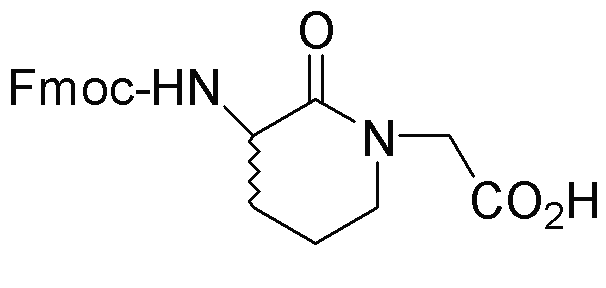Fmoc-(R,S)-3-1-carboxymethyl-2-valerolactame is widely utilized in research focused on:
- Peptide Synthesis: This compound serves as a protective group in solid-phase peptide synthesis, allowing for the selective modification of amino acids while preventing unwanted reactions.
- Drug Development: It plays a crucial role in the design of peptide-based therapeutics, particularly in optimizing the stability and bioavailability of drug candidates.
- Bioconjugation: The chemical is used in bioconjugation techniques, facilitating the attachment of biomolecules to surfaces or other molecules, which is essential in creating targeted drug delivery systems.
- Research on Neuroprotective Agents: It is being explored for its potential in developing neuroprotective agents, contributing to advancements in treating neurodegenerative diseases.
- Analytical Chemistry: The compound is utilized in analytical methods for characterizing complex mixtures, aiding researchers in identifying and quantifying various substances in biological samples.
General Information
Properties
Safety and Regulations
Applications
Fmoc-(R,S)-3-1-carboxymethyl-2-valerolactame is widely utilized in research focused on:
- Peptide Synthesis: This compound serves as a protective group in solid-phase peptide synthesis, allowing for the selective modification of amino acids while preventing unwanted reactions.
- Drug Development: It plays a crucial role in the design of peptide-based therapeutics, particularly in optimizing the stability and bioavailability of drug candidates.
- Bioconjugation: The chemical is used in bioconjugation techniques, facilitating the attachment of biomolecules to surfaces or other molecules, which is essential in creating targeted drug delivery systems.
- Research on Neuroprotective Agents: It is being explored for its potential in developing neuroprotective agents, contributing to advancements in treating neurodegenerative diseases.
- Analytical Chemistry: The compound is utilized in analytical methods for characterizing complex mixtures, aiding researchers in identifying and quantifying various substances in biological samples.
Documents
Safety Data Sheets (SDS)
The SDS provides comprehensive safety information on handling, storage, and disposal of the product.
Product Specification (PS)
The PS provides a comprehensive breakdown of the product’s properties, including chemical composition, physical state, purity, and storage requirements. It also details acceptable quality ranges and the product's intended applications.
Certificates of Analysis (COA)
Search for Certificates of Analysis (COA) by entering the products Lot Number. Lot and Batch Numbers can be found on a product’s label following the words ‘Lot’ or ‘Batch’.
*Catalog Number
*Lot Number
Certificates Of Origin (COO)
This COO confirms the country where the product was manufactured, and also details the materials and components used in it and whether it is derived from natural, synthetic, or other specific sources. This certificate may be required for customs, trade, and regulatory compliance.
*Catalog Number
*Lot Number
Safety Data Sheets (SDS)
The SDS provides comprehensive safety information on handling, storage, and disposal of the product.
DownloadProduct Specification (PS)
The PS provides a comprehensive breakdown of the product’s properties, including chemical composition, physical state, purity, and storage requirements. It also details acceptable quality ranges and the product's intended applications.
DownloadCertificates of Analysis (COA)
Search for Certificates of Analysis (COA) by entering the products Lot Number. Lot and Batch Numbers can be found on a product’s label following the words ‘Lot’ or ‘Batch’.
*Catalog Number
*Lot Number
Certificates Of Origin (COO)
This COO confirms the country where the product was manufactured, and also details the materials and components used in it and whether it is derived from natural, synthetic, or other specific sources. This certificate may be required for customs, trade, and regulatory compliance.


